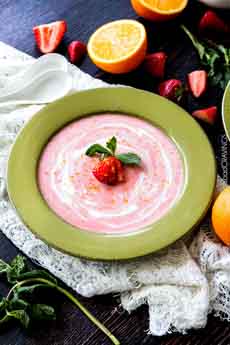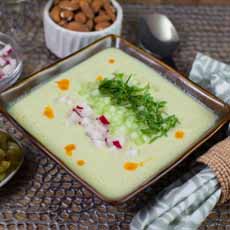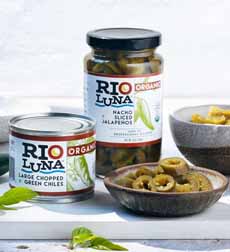TIP OF THE DAY: Fruit Gazpacho, Chilled Summer Fruit Soup
|
|
A specialty of Spain and Portugal, gazpacho is a cold raw vegetable peasant soup originating in Andalusia, the southernmost region of Spain. Originally made from old bread, olive oil and garlic, the recipe was in use when the Romans conquered the Iberian Peninsula (218-19 B.C.E.).
Here’s more history of gazpacho. Over the centuries, gazpacho has evolved in many directions, in terms of regional ingredients and styles. The blender and food processor have enabled versions with silky textures. More recently, chilled fruit soup has been called “gazpacho.” Is every chilled soup gazpacho? Of course not (think of vichyssoise). Many food terms are adapted for marketing purposes. The category to which this recipe belongs has long been called chilled fruit soup. But Pineapple Gazpacho is more relatable and has more pizzazz than Chilled Pineapple Soup, doesn’t it? A chilled purée of strawberry soup should not be called gazpacho, any more than a chilled purée of pea soup. But if your fruit soup contains a variety of ingredients, including herbs, like conventional gazpacho (and the recipe below), we’ll allow it. Yes, we are the Food Police. Prep time is 20 minutes plus overnight marinating. For a main lunch dish, add some protein with grilled or boiled shrimp or scallops. Supplement with crusty bread and olive oil, or a half sandwich. In fact, the next time you’re putting shrimp or other seafood on the barbie, grill some extra for another day’s chilled soup garnish. The seafood not only provides popular flavor; it looks great. You can also serve fruit gazpacho for dessert, enhanced with a scoop of lemon or lime sorbet. Ingredients For 4 First Courses (1-1/2 Cups Each) or 2 Lunch Dishes 1. PLACE the melon, cucumbers, mint, cilantro, vinegar and salt in large resealable bag. Refrigerate overnight to marinate. 2. REMOVE herb sprigs from bag. Transfer contents of bag to blender. Process until mixture is almost smooth. 3. ADD the chiles and the remaining ingredients. Blend until completely smooth. Serve chilled. More recipes on the website. |
|
|
CHILE VS. PEPPER: WHICH IS IT? Wild chiles have been a part of the diet in the Americas since about 7500 B.C.E. While the first chile may have been domesticated in Bolivia, the oldest known traces of have been found in bowls in Ecuador, dating back 6,100 years. Chiles were carried to different parts of Latin America, where soil, climate and cross breeding created many different species. Today there are six species of chiles in the genus Capsicum. But how did we get so many different spellings for the chile? And why are chiles called peppers? Chiles are a fruit, not a vegetable. Here’s the difference between fruits and vegetables. Rio Luna is a brand of the world’s largest producer of green chiles, the U.S.’s largest producer of jalapeños. The products are USDA certified organic, certified kosher by OU, and non-GMO. As a bonus, chiles are fat-free, low-calorie and low-cholesterol. Discover more at RioLunaPeppers.com. |
||



